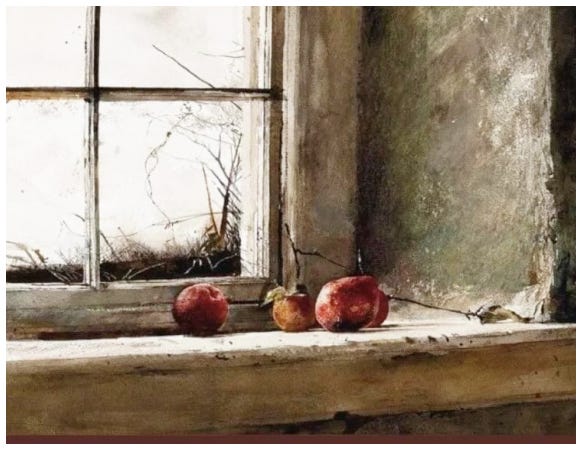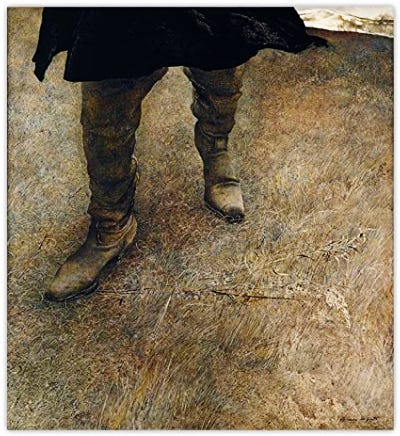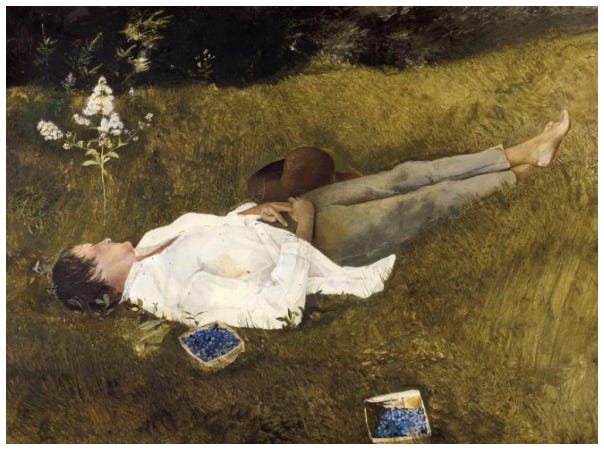Katy - Her Final Story
She was sitting in her armchair with Andrew Wyeth on her lap **A 5-minute memoir
This is a re-posting from January 2023 for my new subscribers. It is one of the Katy Stories.
Her favorite book was on her lap that March morning, a large picture book of Andrew Wyeth’s paintings. She loved his work. She said she could “read” the pictures, that each picture had a story to tell, and she didn’t need any words. She often told me her made up stories about his paintings, but one picture was puzzling to her.
Katy was ninety-six and she spent quite a lot of her days, then, moving in and out of lucidity, as we all do at times, some days more, some days less. She had lived with me for sixteen years and I noticed she was beginning to fail, very slowly at first, and then more rapidly. She wasn’t ill, she was just old and beginning to shut down, piece by piece. It began with small things like forgetting to brush her teeth, or only wanting to eat ice cream, or not wanting to leave the house.
The painting that puzzled her was titled Trodden Weeds. “Now, look at this one,” she said. “I have been trying to figure out this picture. Who do you think that man is? Where is he going? Why is he wearing those big old knee boots?”
I told her I didn’t know the story, but that I would find out. I began writing that evening, and produced just one paragraph.
“…. He looked at his reflection briefly in the old mirror hanging near the kitchen door. For want of a comb, he wet his hand at the faucet and smoothed down the mouse-brown hair on top of his head. He whacked his hat against his thigh a couple of times, sending the dust flying, and put it on his head. Stepping out onto the sagging porch, he surprised three morning crows in the empty yard. They barked the usual insults at him and hopped over to the watering trough as he walked by.”
When I awoke in the morning, his name was rattling around in my head. It had come to me in a dream. Bartle Clunes. I got my morning coffee, sat down in a sunny window and wrote two more paragraphs. In the afternoon, I told mama I was writing about her mystery picture. I read to her what I had so far. She settled back with the picture-book open on her lap.
“Setting out across the barren fields, Bartle Clunes, could sense the subtle changing of the season, he felt snow coming. The sky was clear, the air had a sharp bite and a dampness to it, the frosted stubble of grass crunched under his tread. The tops of his tall worn boots flapped against his knees as he walked. He pulled his handkerchief out of his pocket and blew his nose.
“Buttoning the collar of his dark wool coat against the late October chill, Bartle was heading over to the sunnier side of the draw to see Louvina McBean. He was either going to ask her to marry him or he was going to buy one of her dogs. He hadn't decided which. The only thing he did know was that he was done living alone.”
I wrote a little every day, and read to her. Sometimes I would read to her in the morning and by the afternoon she would have forgotten and would ask me, “What is old Bartle up to today?” And I would read it again. After a few months, (and forty-five chapters later), she came to think of Bartle as a friend. The foothills landscape in which he lived was real to her. She looked forward to visiting that small invented settlement in the California Gold Country. She knew the names of all the characters and talked of them as if they were her neighbors, and, I guess, in a way, they were.
I didn’t write the story with publishing it in mind; it was for Katy. Oh, I can write readable stories, but I have no pretensions of having the talent or the stamina or the temerity it takes to sell a manuscript. This story was simply the perfect vehicle for my mother and me to spend meaningful time together in the last months of her life.
We had long talks about life in Riles Crossing. She loved that it was uncomplicated, there was no meanness and very little sadness in their world. They all got along and helped each other. She recognized that the language used was the rural language of her generation in 1949. She remembered the colorful idioms and the polite, rather formal language that people used in those days. In the dialog I wrote, I heard my grandmother’s voice.
Without any preconception, Bartle Clunes became a tale of redemption, of finding room in one’s life for the most unlikely people. It turned out to be a testament to the power of friendship, and how it may change one’s life and the lives of an entire community. And it made a difference in my mama’s end days, I am sure of it.
As it turns out, over two hundred people now have read Bartle Clunes on Substack and in paperback. I could not be more delighted. Let me shamelessly suggest that if you have a friend or family member in their older years, share Bartle Clunes online with them. It would be a sweet gift. It is free and is presented chapter by chapter. And if you are a caregiver for an elderly or a housebound person, they might even like you to read it to them. The Bartle Archive is HERE .









Thank you Sharon the Bartlett story is a wonderful gift.
How wonderful to create a story with which Katy could identify and become immersed. I love your Katy stories. Thanks for bringing this one out of the archive. The Andrew Wyeth paintings are beautiful, and apparently, inspirational.